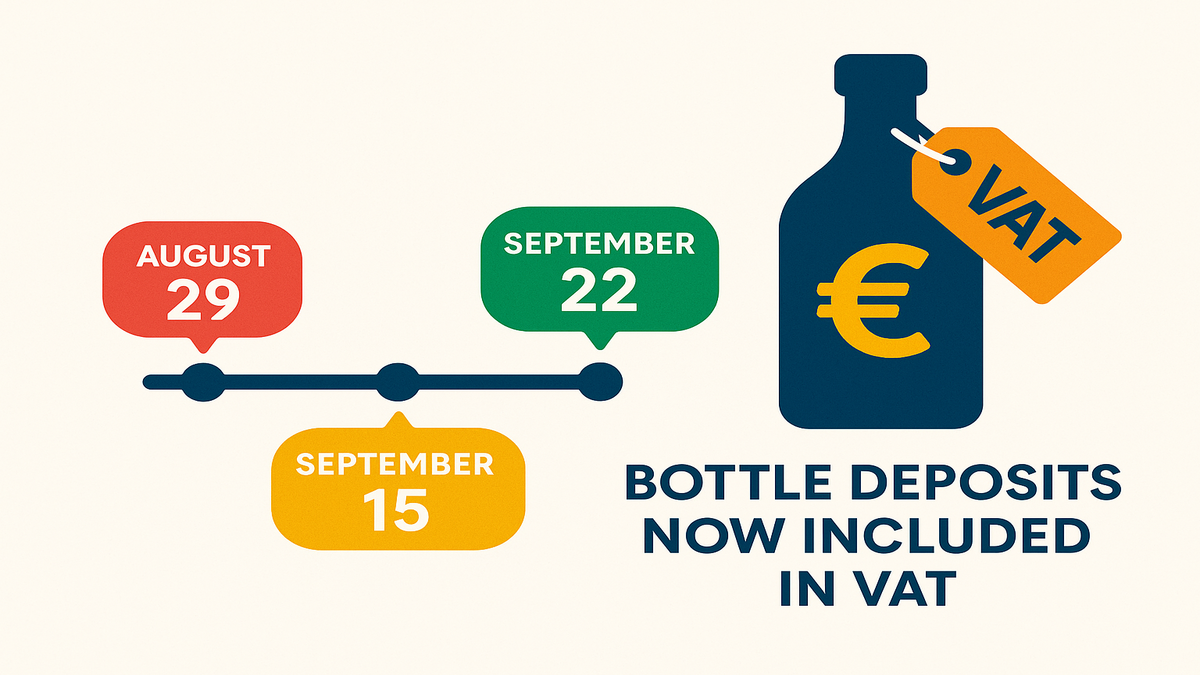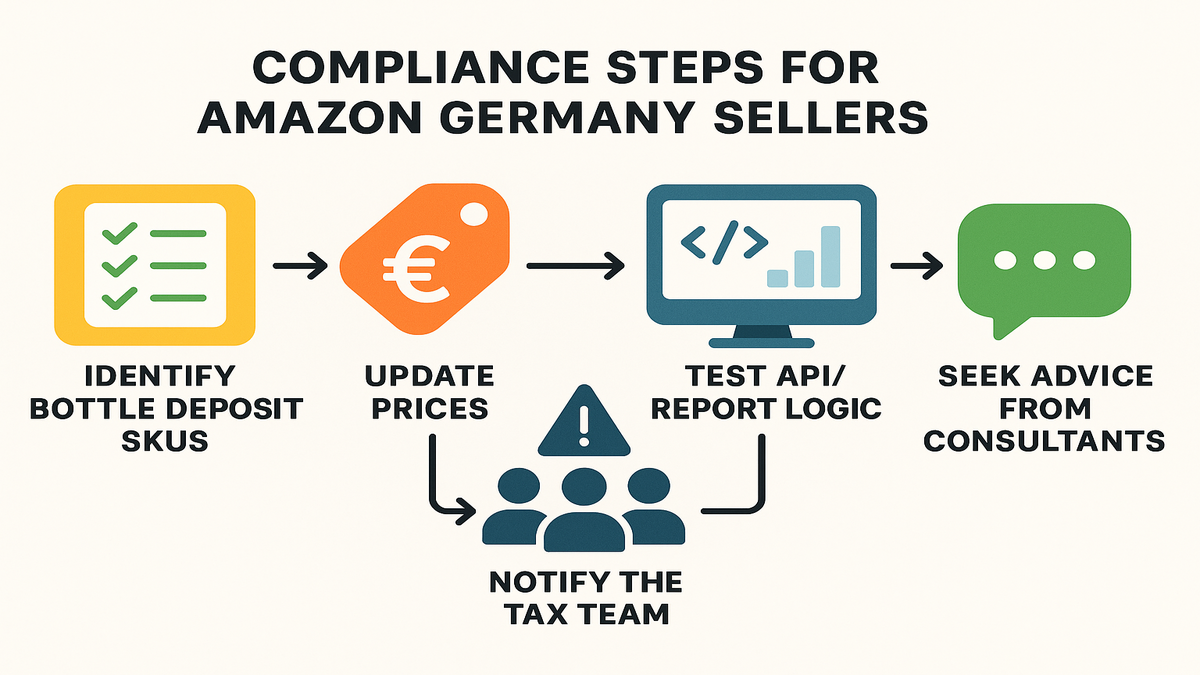
Amazon Germany Sellers: Bottle Deposit VAT Change Hits Soon

Heads up: Even pros selling on Amazon Germany mess this up sometimes.
VAT on bottle deposits? It’s not some simple checkbox. If you slip, it can blow up your whole setup. And—yeah—the rules are getting switched up. Again.
Here’s the thing: Amazon just changed the date for how they handle VAT on bottle deposits in Germany. Mark September 22, 2025. If you thought you had till October, sorry. Clock’s ticking. Miss it, and you might see your profits vanish.
If you skip the bottle deposit part, prices get wonky, taxes turn into a mess, or even worse—your Seller Central account could get flagged. Don’t treat compliance like busywork. It’s real cash at stake.
The basics: Bottle deposit fees—those few cents extra for recycling—are now counted for VAT in Amazon’s reports. If your prices or accounting tools don’t adjust, any mismatch eats your profits. Don’t sweat, I’ll explain what’s changing, what it means for you, and how to dodge drama.
Key Takeaways:
- Amazon adds the whole bottle deposit to Germany VAT calculation reports, starting September 22, 2025.
- You must update your prices and how you report, since VAT hits both the product and the deposit.
- Reports in Seller Central and SP-API are affected—so adjust your tech stuff too.
- Get it wrong and you’ll see price errors, tax slip-ups, or even get a warning from Amazon.
- Get prepped: fix your systems, tell your tax person soon, and double-check your API stuff before the deadline.

Why Amazon Germany Is Mixing It Up
Why Now? Why Should You Care?
Bottle deposit fees—“Pfand” in Germany—aren’t some new thing. But the rules around them? Annoyingly picky, especially for taxes. German law says VAT is on the total—the product price plus the deposit. So, every cent has to line up, even the smallest Pfand charge.
Amazon’s changing how it does VAT for a reason. They want to: Stay on the right side of German tax laws, and make receipts clear for shoppers. Get it wrong and you’re looking at fines, missed money, or even a bunch of angry emails from confused buyers.
Like one top VAT consultant at Avalara put it: “Ignore deposit VAT and you’ll get burned, especially now audits check everything. Big marketplaces get more heat.” Amazon’s just getting in line with EU law. But guess what—it’s up to you (the seller) to keep up.
Timeline Whiplash
Compliance Never Sleeps
If you feel mixed up by constant changes, same here. First, Amazon picked August 29, 2025. Then September 15th. Now it’s September 22. Why all the back-and-forth? Sellers pushed back. Folks weren’t ready to re-do pricing or API stuff with hardly any warning. So Amazon gave a little more time. Use that time—seriously.
Quick date recap:
| Initial Planned Date | Revised Dates | Notes | |---------------------|---------------------|------------------------------------| | August 29, 2025 | September 15, 2025 | First push to give sellers prep | | September 15, 2025 | September 22, 2025 | Final delay for code & rollout |
That extra week isn’t nothing. Use it to check and double-check your prices and systems. Your customer receipts and tax filings must match what Amazon spits out.
Here’s why it’s big: If your logic doesn’t match Amazon’s new style for bottle deposits, all those small cents add up—fast. By busy season, it could mean hundreds or thousands lost. Not small change.
What’s Changing in Your Reports
Watch the Details
So it’s not just a date change. Starting September 22, 2025, every VCS report for Amazon Germany will show the full Pfand deposit in the “OUR_PRICE Tax Inclusive Selling Price.”
What’s that mean for you?
- Bottle deposits count as part of the sales price for VAT—no exceptions.
- VAT is now on price + deposit, so every cent counts at tax time.
- Every VCS line, every invoice, every API pull—it all shows higher tax-inclusive totals if deposits are involved.
If you pull manual CSVs from Seller Central or use the SP-API for your software, update your system now. If your software or accountant doesn’t, their numbers could be off by the full amount of those deposits. Thousands of sales turn a small miss into a major pain.
Here’s a true story: A seller from Berlin said this after last year’s draft:
“We missed a few hundred euros at tax time because deposits popped up late. Fixing it was a nightmare. If Amazon had done it up front, we could’ve fixed it in two minutes. Lesson learned: automate and check before the rule changes.”
Don’t want headaches? Tools like Requery handle deposit tracking for you and can close those tax gaps fast.
Price and Compliance Effects
Real Risks to Real Cash
Bottom line: If you ignore this, here’s what you risk:
- Wrong Prices: Your prices might look weird or jump for buyers if deposits aren’t clear.
- Tax Trouble: Messed up VAT? Get ready for audits or even fines. Germany’s tax folks have eagle eyes for missed VAT.
- Angry Customers: Mix up VAT breakdowns and people will ask for refunds, write bad reviews, or jam your support chat.
- API Mess: If your system doesn’t grab new bottle deposit info, your accounting or inventory tools break. That’s days lost and sales missed.
From a leading tax tech developer:
“Biggest headache is API users forgetting to add new fields. Our busiest support months come after Amazon report changes, because everyone waits too long to fix their code.”
So don’t just slap on a patch. Rethink your pricing and reporting.
Make Your Setup Bulletproof
Checklist for Sellers
Let’s be real—this deposit change isn’t the last twist you’ll see. Rules in the EU keep shifting, especially for stuff like bottle deposits. Build your process to handle curveballs—or expect headaches.
Here’s your quick to-do list:
- Review Your Products: Find every SKU with a bottle deposit. If you sell drinks, you’re probably in scope.
- Check With Your Tax Provider: Don’t stall. Ping your tax software team. Make sure they’re updating things—and find out who handles what.
- Test Your API: Update code in your ERP, bookkeeping, and macros so the new deposit and VAT totals show up right. Use Amazon’s sandbox to double-check.
- Update Your Prices: Bake deposits into your full, tax-inclusive prices. Roll these out and let your shoppers know if you can.
- Log Your Changes: Make notes every time you tweak stuff. In six months, you’ll thank yourself at tax time.
- Ask for Real Help: Not sure you got it? Have a tax pro take a look—beats getting hit with audit fines.
A sharp seller in Germany put it best:
“Skipping a field in a report feels tiny until you’re missing thousands in VAT. Take a day to double-check your setup now—future you will be glad you did.”
And hey, German tax folks don’t forget, so don’t slack now.

Where Does This Leave You
Let’s sum it up:
- Bottle deposits will show up in the VAT-inclusive price after September 22, 2025.
- There’s no more deadline delay. This is it.
- Update listings, prices, API code, and reports before Amazon flips the switch.
- Confused? Ask a pro or use big-name solution shops like Avalara, KPMG, or Amazon’s partner list. Way cheaper than risking a mistake.
Easy way to stay chill?
- Turn on Amazon’s VAT service if you haven’t. It does a lot—but only if your info is right first.
- Sell across the EU? Watch for similar rules. VAT on bottle deposits is popping up everywhere from California to Asia.
Got more than one Amazon account? Try AMC Cloud to keep your data straight—even if you have lots of channels, privacy hurdles, or rule changes.
TL;DR
- Bottle deposits are counted in VAT and listed prices—starting September 22, 2025.
- Update manual and API setups now. Amazon’s not shifting the date again.
- If you ignore this, VAT filings will be wrong or buyers will get wrong info.
- Test early to avoid last-minute mess. Make sure prices and code are right before Q4 rush.
- Still lost? Ping Amazon support, a tax expert, or a VAT solution shop for help.
FAQ
Q1: What’s a bottle deposit on Amazon DE, really?
A: Classic Pfand stuff—bottled drinks like water, soda, juice, beer. From September 22, 2025, the fee is now part of VAT-inclusive prices in Amazon reports.
Q2: I sell beverages on Amazon.de. Do I have to do something?
A: Yes. Review all your drink items, be sure the right deposit fee is in the listing, fix your code, and check your accounting tools are ready.
Q3: How does this affect my taxes?
A: You must now include the bottle deposit in your VAT filing. That matches German law and drops audit risks. Miss it and you’ll face fines or flags.
Q4: I use SP-API. What do I change?
A: Update your code so every price and VAT field from VCS reports now includes the deposit. If not, your whole process—ETL, reconciliation—breaks. Not pretty.
Q5: Does this change what my buyers see or just my internal numbers?
A: Both. Customers see prices (with deposit) in their orders and confirmations. If you haven’t updated your docs or support yet, get ready for more questions.
Q6: Who do I ask for help?
A: Start with Amazon Seller Support. Then your tax or software person. Still not sure? Book a session with a pro EU VAT advisor or Amazon Solution Provider. That goes double if your tech setup is tricky.
5 Steps Before The Deadline
- Find all your bottle-deposit SKUs.
- Plug deposits into product prices—tax included.
- Test reports and SP-API for new fields, numbers, and VAT logic.
- Loop in tax and finance so their numbers match the new Amazon data.
- If you get stuck, ask Amazon or a VAT pro for help.
So next time you upload products, don’t slack off with deposits. The only thing worse than an empty bottle? A shock tax bill. (And only the bottle refund’s good news.)
Need more info? Go read up on European VAT Calculation Services or learn about Deposit Return Systems in different shops.

